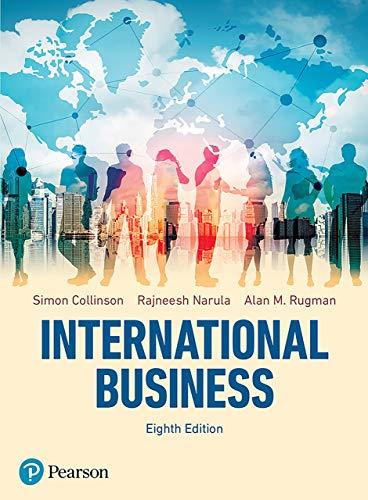3M is a major MNE with over 55,000 products sold in 200 countries, comprising everything from office
Question:
3M is a major MNE with over 55,000 products sold in 200 countries, comprising everything from office supplies to construction and building maintenance to chemicals. In 2017, it employed over 90,000 people, had operations in more than 70 countries and generated $31.7 billion in revenue. Taking this into account, one may question: how does the firm manage such a large international operation? One way is by adapting its global strategies to the needs of local markets.
The company balances its global strategies and national responses on a region-by-region basis. For example, in Europe the company has set up a series of business centres to address local differences. The company also uses European management action teams (EMATs) to balance the needs of subsidiaries in responding to local expectations with the corporation’s need for global direction. Today, 3M has 50 EMATs in Europe, each consisting of from 8 to 14 people, most of whom are marketing personnel. These groups are charged with bringing the firm’s global plans to life by helping their execution at the local level. EMAT meetings, which usually occur quarterly, are designed to create action plans for the European subsidiaries. When the meetings are over, the members then return to their respective subsidiaries and begin executing the plans. In Asia the company uses a different approach, relying heavily on its Japanese operation to provide much of the needed direction to the subsidiaries. At the same time, there are regional centres in Singapore and South Korea that help subsidiaries to address their local markets. In Latin America, meanwhile, 3M uses a macro approach, conducting business on a national rather than regional basis.
3M is seen by some as one of the first global manufacturing firms to integrate environmental sustainability into its global strategy, across all its operations, despite the obvious organisational complexity outlined above. It was among the first group of firms to be listed on the Dow Jones Sustainability Index when it started in 1999. In 2014 it won the US Environmental Protection Agency’s (EPA) ENERGY STAR® award for the tenth year in a row for its worldwide energy-conservation efforts. These awards, alongside a range of indicators which the firm uses to measure its progress as a responsible company, suggest that it is genuinely concerned about its wider stakeholders. These examples come from its Annual Sustainability Report (2015):
. 3M’s Pollution Prevention Pays programme has prevented nearly 2 million tons of air, water and waste pollution, and the reduction of the company’s global greenhouse gas emissions by 57 per cent from 2002 to 2013 on an absolute basis (even as the company sales grew 30 per cent over the same period of time).
. Ongoing support to protect and restore vital ecosystems around the world. By working with partners such as The Nature Conservancy, the 3M Foundation has provided more than $21 million to preserve more than 1 million acres.
. More than $61.6 million in global cash and in-kind product donations in 2013.
. In 2014 3M joined the United Nations Global Compact, formalising its commitment to the ten principles of the Compact in the areas of human rights, labour, the environment and anti-corruption.
In 2015, 3M also asserted that they had set a sustainability 10-year goal cycle. Some of the 2025 sustainability goals are as follows:
. Reduce manufacturing waste by an additional 10 per cent, indexed to sales;
. Achieve ‘zero landfill’ status at more than 30 per cent of manufacturing sites;
. Reduce global water use by an additional 10 per cent, indexed to sales;
. Improve energy efficiency indexed to net sales by 30 per cent;
. Increase renewable energy to 25 per cent of total electricity use;
. Provide training to 5 million people globally on worker and patient safety;
. Invest cash and products for education, community and environmental programmes; and
. 100 per cent participation in employee development programmes to advance individual and organisational capabilities.
Some firms develop sophisticated vision and mission statements or advertising campaigns to promote their ethical or environmental credentials. It is always worth looking at the evidence and in 3M’s case the rhetoric does seem to be matched by the numbers.
Step by Step Answer:

International Business
ISBN: 9781292274157
8th Edition
Authors: Simon Collinson, Rajneesh Narula, Alan M. Rugman





